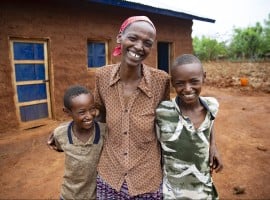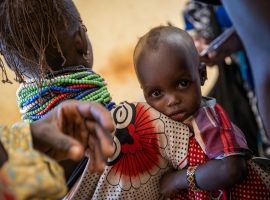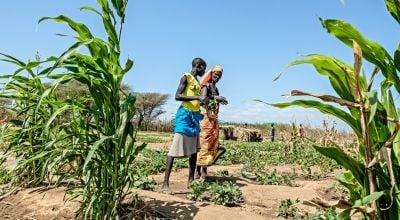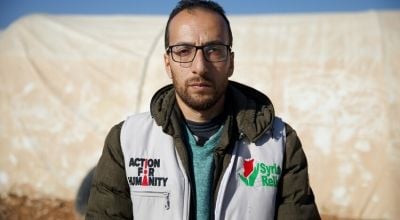
Read our 2024 annual report

Knowledge Hub
The most common natural disasters present some of the biggest threats to the most vulnerable people.
Natural disasters are, well, natural. They’re hazards of nature that we can’t fully prevent (historically, we’ve always experienced floods, droughts, and wildfires). But in the last few decades they’ve also become more frequent, more severe, and more impactful.
While these events are devastating for everyone, they pose a disproportionate risk for people living in poverty. Those with the fewest resources to cope with an emergency stand to lose the most and fall furthest behind in recovery. If we’re going to win the fight against poverty, we therefore need to take this into account. These nine types of natural disaster are among the most common, and present some of the biggest threats to ending poverty for good.
1. Floods
Floods are the most common natural disaster around the world in terms of frequency, geographic reach, and impact. Between 1995 and 2015, floods accounted for 43% of all recorded natural disasters. In that time, there were 3,062 floods recorded. Over the last decade, however, frequency and impact have increased, with several countries experiencing the worst floods on recent historical record in the last few years, including:
- The 2024 floods in Bangladesh
- The 2022 floods in Pakistan
- The 2023-24 floods in Somalia
- The 2021 floods in South Sudan
Floods are often linked to storms (including a few types below) when existing courses (like rivers or coastlines) can’t handle the excess water, but can also happen as a result of earthquakes. This increases their frequency and risk, as well as risks associated with flood recovery like waterborne diseases, contamination from mould or leftover debris, and — in agricultural regions — lost crops and livestock.
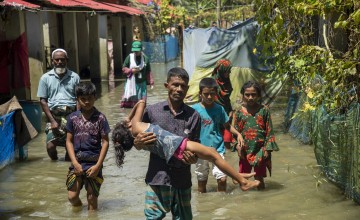
2. Cyclones, hurricanes, and typhoons
Cyclones, hurricanes, and typhoons are all the same type of storm, referred to collectively as “tropical cyclones.” Though they have different names, they’re all structurally the same: they spin (either clockwise or counterclockwise) and feed off of warm air over an ocean. If they form over the Atlantic Ocean, they’re called hurricanes. In the northwest Pacific region they’re typhoons, and in the south Pacific and Indian Ocean region they’re cyclones.
Their impact is also the same regardless of the name: flooding, tornadic activity, death, and destruction, with the most vulnerable communities often hit hardest by the loss. In the same survey that ranked floods as the most destructive natural hazard, storms ranked second most-destructive, accounting for 28% of all disasters between 1995 and 2015. In recent years, we’ve also seen a rise in storms labelled “unprecedented”:
- In 2019, Malawi and Mozambique were hit by Cyclone Idai. Just four years later, that same region was hit by the even stronger Cyclone Freddy.
- In 2020, Bangladesh faced its worst storm in 20 years with Cyclone Amphan. Three years later, it sustained further damage from Cyclone Mocha.

3. Tsunamis
Unlike tropical cyclones, which begin in the atmosphere, tsunamis begin underground and are the result of an earthquake forming under a body of water.
Among the most devastating tsunamis in recent history was the tsunami that struck southeast Asia on December 26, 2004. An underwater earthquake measuring 9 on the Richter scale triggered a series of tidal waves that affected 12 countries, with a combined death toll of over 150,000. Concern responded to this in two of the countries hit hardest in terms of high impact and low resources: Sri Lanka and Indonesia.

4. Earthquakes
According to the UN’s Office for Disaster Risk Reduction (UNDRR), earthquakes killed nearly 750,000 people between 1994 and 2013, more than all other natural hazards combined. Things get more complicated when earthquakes happen in coastal areas (particularly in the Pacific), triggering both earth-based tremors and tidal waves, or when they hit in areas that are experiencing other forms of crisis at the same time. Just a few seconds of tectonic activity can lead to years of devastation.
- Learn more about the 2025 Myanmar earthquake
- Learn more about the 2023 Türkiye-Syria earthquake
- Learn more about the 2022 earthquake in Afghanistan (and the country’s 2015 quake)
- Learn more about the 2021 earthquake in Haiti (and its even more devastating 2010 quake)
- Learn more about the 2015 Gorkha earthquake in Nepal
They’re among the most difficult hazards to predict or prevent against, although there are ways we can reduce the risks associated with them (especially in building codes). These methods can help to not only reduce the loss of lives and homes, but also similar knock-on effects as floods — especially increased risk of diseases due to damaged infrastructure.
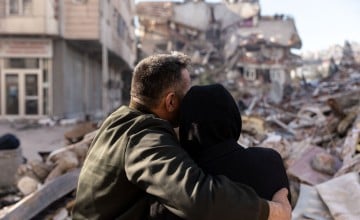
5. Landslides and mudslides
Large-scale downhill movements of debris and dirt (landslides) or mud and sediment (mudslides) are often a result of an earthquake or volcanic eruption, although they can happen independently of these events as well. This was the case in 2021 in Bangladesh, when an excessive rainy season led to deadly landslides in the large and vulnerable Rohingya refugee camp in Cox’s Bazar. These came just a few years after a series of 2017 landslides were labelled the most deadly in the country’s recent history.
2017 was also the year that heavy rains triggered severe mudslides in Sierra Leone, killing hundreds and displacing thousands just after the city of Freetown had managed to eradicate history’s largest Ebola outbreak the year before.

6. Volcanic activity
Volcanoes are among the rarest occurrences in terms of frequency, but they can still have catastrophic consequences depending on the type of eruption. Fast-moving lava can wipe out villages, and slow-moving lava can lead to pressure build-up and explosions that are more dangerous than the initial eruption. While we’ve been able to anticipate some of the risks posed by volcanic activity, there are still many factors beyond our control.
A recent example of this was the 2021 Mount Nyiragongo eruption, near the eastern Democratic Republic of the Congo city of Goma (triggered in turn by an earthquake in the area). Adding to an already complex humanitarian crisis in the eastern part of the country, the eruption of Mount Nyiragongo forced hundreds of thousands to flee. Thousands of houses and public buildings, along with water and other infrastructure, were destroyed or damaged, and 17 villages were destroyed.

7. Heatwaves
Last summer, the European Union’s Copernicus Climate Change Service (C3S) recorded July 21, 22, and 23 as the hottest days on record. The global heat wave peaked on July 22, 2024 at a worldwide average of 17.16ºC, making it the hottest day in modern history, and in some areas the temperatures went as high as 50ºC — halfway to boiling. Last year, UN Secretary-General António Guterres noted that excessive heat leads to 23 million workplace injuries worldwide each year, and when daily temperatures rise above 34ºC, labour productivity drops by 50%. Heat stress in the workplace is expected to cost the global economy $2.4 trillion by 2030 (it was at $280 billion in the mid-90s).
While we don’t see catastrophic visible damage from a heatwave the way we would from a flood or an earthquake (or even a drought in rural areas), extreme heat has the highest mortality rate of all extreme weather events. It’s especially threatening to many workers with the fewest protections, such as street vendors and construction teams, as well as people who live on the streets and don’t have a place to shelter from the heat. They’re also more dangerous for children, the elderly, and people with other pre-existing health conditions.
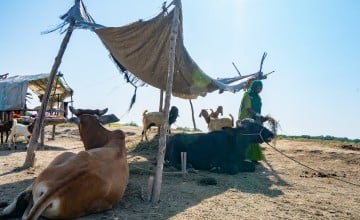
8. Wildfires
A 2022 study conducted by the University of Georgia revealed a direct link between wildfires and poverty, concluding that “counties with moderate-to-high wildfire risk are more likely to have higher poverty rates.”
Even in high-income countries with comparatively fewer people living below the poverty line, however, the destruction of wildfires carries a large price tag, and their damage disproportionately affects people with the fewest resources to cope. The Australian bushfires of 2019-2020 cost the country’s farmers between $4 and $5 billion Australian dollars, about 8% of the industry’s GDP. Initial, conservative estimates for the total costs of the Los Angeles wildfires earlier this year tally the damage at $250 to 275 billion US dollars.
Fires at a smaller scale can be just as devastating at a personal or community level. This is especially true for hundreds of thousands of Rohingya refugees living in informal camp shelters in Cox’s Bazar, Bangladesh. Last year, the Kutupalong camp suffered its most devastating loss with a January 2024 fire that destroyed about 800 shelters and displaced 7,000. A fire in Rohingya Camp 1 West last December killed two and displaced 4,000.

9. Drought
Droughts are among the most protracted natural disasters, as season after season of failed rains stack up on one another. What’s more, droughts are increasing in terms of frequency, severity, and impact, with UNDRR estimating a 29% increase in these factors since 2000. Of 1.84 billion people experiencing drought, nearly 5% were facing severe or extreme drought conditions.
Again, people living in poverty are hit hardest, with the UN’s Convention to Combat Desertification reporting that 85% of people affected by droughts live in low-or middle income countries. This report came at the tail-end of the 2020–2023 Horn of Africa drought, which had left 23 million people in Ethiopia, Kenya, and Somalia severely food-insecure as a result of years of failed rains. This also meant that, when the rains finally came to the area, the ground wasn’t prepared for so much water. As a result, communities that had seen little to no water for years were quickly flooded.
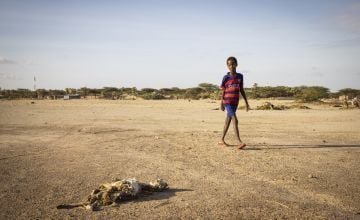
Natural disasters: Concern’s response
Emergency response is part of Concern’s DNA, and a large part of our work over nearly six decades has been in helping families living in poverty recover from natural disasters and build resilience in the face of future disasters. Much of that work falls under the umbrella of Disaster Risk Reduction, a series of approaches and strategies that help people identify the risks in their communities and build systems to better anticipate, respond to, and mitigate against them.
We’re also often among the first organisations to respond when an emergency strikes, and we focus on both large-scale disasters (such as the 2023 Türkiye-Syria earthquake) as well as smaller or more localised natural hazards that can still spell catastrophe for the people affected by them. We provide frontline support as well as longer-term recovery, with an aim to also build resilience in communities prone to cyclical or seasonal risks. Learn more about our approaches to natural disasters in the articles below.
